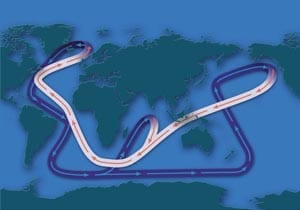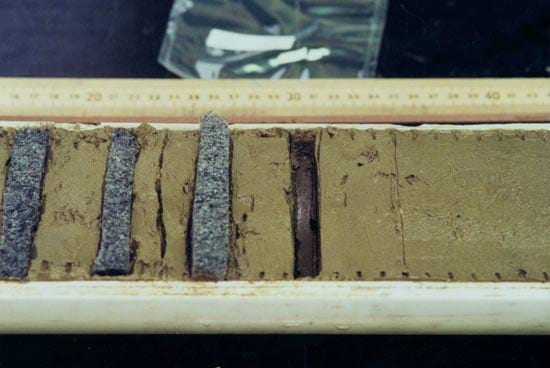Fine-tuning the Steps in the Intricate Climate Change Dance
December 7, 2005
New scientific findings are strengthening the case that the oceans and climate are linked in an intricate dance, and that rapid climate change may be related to how vigorously ocean currents move heat between low and high latitudes.
The research, by Candace Major, an investigator at Woods Hole Oceanographic Institution, was presented today at a press conference at the fall meeting of the American Geophysical Union in San Francisco.
In the North Atlantic region, the glacial climate has been characterized by abrupt climate swings between cold, or stadial, conditions and relatively warm or interstadial conditions like the present. Scientists have theorized that stadial-interstadial transitions were most likely caused by changes in the strength of the thermohaline circulation in the North Atlantic Ocean. Thermohaline circulation, the global ocean circulation system, is driven by differences in the density of sea water, which is controlled by temperature (thermal) and salinity (haline). In the North Atlantic the system transports warm salty water poleward, where the water cools and sinks into the deep ocean. This newly formed deep water is subsequently exported southward, driving the conveyor.
Major’s findings build on research reported in 2004 suggesting that when the rate of the Atlantic Ocean’s north-south overturning circulation slowed dramatically following an iceberg outburst during the last deglaciation, the climate in the North Atlantic region became colder. When the rate of the ocean’s overturning circulation subsequently accelerated, the climate warmed abruptly.
Major, a postdoctoral scholar in the WHOI Geology and Geophysics Department, took the 2004 studies a step further back in time, into the heart of the last ice age 30,000 to 60,000 years ago. Using the same technique that compares the abundance of two naturally occurring isotopes, protactinium and thorium, she compared the temperature record of an ice core from Greenland to a sediment core collected on the Blake Outer Ridge off the east coast of the United States.
Protactinium and thorium are daughter isotopes of naturally occurring uranium in seawater. Thorium sticks better to sinking particles and most of it falls quickly to the ocean floor, while some percentage of protactinium will be exported out of the North Atlantic by prevailing currents. In the last 20,000 years, the ratio of protactinium to thorium (Pa/Th) has increased when ocean circulation was strong, and decreased when ocean circulation was weak.
Major found similar results going back 60,000 years ago. Northern hemisphere temperature has varied with the strength of ocean circulation over the past 60,000 years. Warm periods have occurred when the overturning circulation was strong, while cold periods occurred when circulation was weak.
“The temperature record from the ice core results correlates very well with the sea surface temperature measured in the sediment core much further to the south,” Major said. “Freshwater input to the North Atlantic, largely from melting glaciers and icebergs, seems to decrease the strength of the overturning. During cold periods, coarse debris is found in cores at the Blake Outer Ridge, attributed to ice-rafted debris brought by melting icebergs far south of their range in warm periods, like today.”
“We need to understand what the rate of the overturning is,” Major said, “because it is the rate of flow that determines the amount of heat transported by the oceans. The variations we have seen are too frequent to be explained only by the changes in the distribution of sunlight reaching Earth’s surface, which is our best guess at the most powerful external force influencing climate.”
Thorium (Th) resides in the water column no more than a few decades before settling to the sea floor. Protactinium (Pa) is removed less readily and thus remains in the water column 100 to 200 years. As a result, about half of the protactinium produced in North Atlantic water today is exported out of the North Atlantic as part of the ocean circulation system known as the great conveyor. But in cold periods when circulation is weak, the percentage exported out of the North Atlantic is close to zero.
Colleagues Jerry McManus, Lloyd Keigwin and Susan Brown-Leger at the Woods Hole Oceanographic Institution and Roger Francois at the University of British Columbia with graduate student Jeanne-Marie Gherardi first used the Th/Pa method in 2004 to study ocean circulation and abrupt climate change during the past 20,000 years. They found that the coldest interval occurred when the overturning circulation collapsed following the discharge of icebergs into the North Atlantic 17,500 years ago. This regional climatic extreme began suddenly and lasted for two thousand years. Another cold snap 12,700 years ago lasted more than a thousand years and accompanied another slowdown of overturning circulation. Each of these two cold intervals was followed by a rapid acceleration of the overturning circulation and dramatically warmer climates over Northern Europe and the North Atlantic region.
Major says nutrient proxies, such as carbon isotope ratios, have been widely used to reconstruct water mass reorganizations associated with this so-called stadial-interstadial or cold-warm variability. While these tracers help determine the volume of water represented by each of these water masses at any one point in time, they don’t provide direct information about the rate of thermohaline circulation.
Ocean scientists have long suspected that strong overturning circulation leads to warm conditions in the North Atlantic region, and weak overturning circulation leads to cold conditions. Major’s study is the first to apply the novel Pa/Th technique to get an estimate of Atlantic circulation rates in the deep past during the heart of the last glacial period.
“Something is different about the ocean’s circulation at times of rapid climate change, and it appears that the difference is related to changes in the rate of ocean circulation,” Major said. “Are these changes unique to deglaciation, or are they a characteristic of abrupt climate changes over the more distant past?” The answer, according to the work presented by Major at this meeting, seems to be that such changes occur throughout the last glacial cycle.
AGU Related session: OS33D-06 14:55h Shifts in Atlantic Ocean Circulation During the Last Ice Age: A 231Pa/230Th Record of Marine Isotope Stage 3


